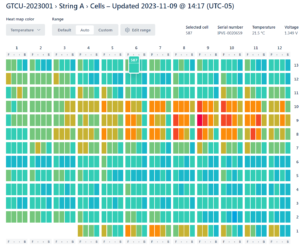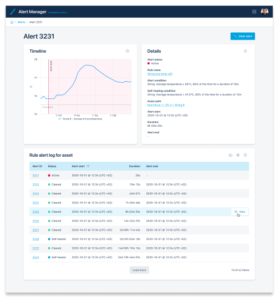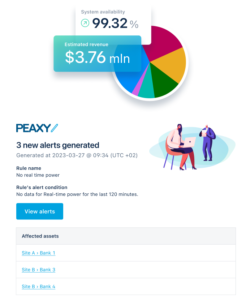One of the main potential hazards of battery energy storage systems (BESSs) is thermal runaway, which is a rapid uncontrolled release of heat energy from a battery cell. This can result in a chain reaction that heats up neighboring cells and releases hot flammable and toxic gasses, which can ignite and cause a fire or explosion that can spread to other parts of the system.
Thermal runaway can be triggered by mechanical damage, electrical faults or overheating of the battery. Another cause is improper charging or handling of the batteries, which can lead to short circuits or overcharging. A common factor that contributes to the intensity and difficulty of extinguishing battery energy storage fires is the presence of flammable electrolytes in the lithium-ion cells. These electrolytes fuel the fire and make it resistant to water or conventional fire suppressants.
According to FEMA, in April 2019, an unexpected explosion of batteries on fire in an Arizona energy storage facility injured eight firefighters. According to a report released by APS in July 2020, the fire and explosion at the McMicken Energy Storage facility was caused by an internal cell defect in one of the lithium ion batteries, which triggered a cascading thermal runaway event1. The report also found that the firefighters did not have a proper response plan for dealing with the battery fire, and that the fire suppression system was inadequate for the size and nature of the fire2. The report recommended several safety measures for future battery installations, such as improved fire detection, ventilation, and isolation systems3.
This year alone has seen at least 9 instances of fires4 at battery energy storage facilities, raising concerns about safety around this emerging technology. According to media reports, at least four major incidents have occurred in New York, California and Arizona, involving lithium-ion batteries that overheated and ignited. These fires have prompted state authorities to launch investigations and create fire safety working groups to evaluate the causes and effects of the battery storage fires, as well as to review the existing codes and standards for energy storage systems. They have also highlighted the need for more public awareness and emergency preparedness around battery storage facilities, especially as they are expected to play a key role in the transition to a clean energy future.
To prevent or reduce the risks of these hazards, BESSs need to have proper detection and protection systems in place. These systems include fire detection and suppression, gas detection and ventilation, thermal management and monitoring, electrical isolation and grounding, emergency disconnects and signage, personal protective equipment, and emergency response plans. Additionally, BESSs need to comply with relevant codes and standards, such as NFPA 855, UL 9540, and IEEE 1547.
One important way to enhance the safety of BESSs is to smartly use battery analytics that can provide insights into thermal problem areas by monitoring voltage and heat at the battery cell level. This can help identify potential failures before they escalate into thermal runaway or other hazardous scenarios. Our own battery analytics solution, Peaxy PLI (Predictive Lifecycle Intelligence), can address provides features such as:
Real-time monitoring of battery health and performance
Real-time monitoring of battery health and performance is a key feature of a battery analytics solution to enable battery owners and operators to track the status of their batteries, identify potential issues, optimize performance, and extend battery life. Real-time monitoring can provide valuable insights into the battery’s voltage, temperature, current, power, state of charge, and state of health. By analyzing these parameters, users can detect anomalies, diagnose faults, prevent failures, and optimize charging and discharging cycles, staying within manufacturer guidelines to avoid warranty issues. Real-time monitoring can also help users reduce operational costs, improve safety, and enhance customer satisfaction. A battery analytics solution such as PLI that offers real-time monitoring can provide a competitive edge and direct revenue impact.

PLI (Peaxy’s battery analytics solution) can integrate with any existing data infrastructure and collect data from various sources, such as R&D labs, manufacturing plants, hardware integration systems, grid services, and transportation fleets. This data is then made available through a user-friendly interface that allows users to access and visualize their battery data in real time, in a few clicks, and in a much easier way than creating a one-off bespoke application or dealing with more limited and generalized off-the-shelf graphing tools. In this example, battery owners and operators can view live data about temperature and voltage down the individual cell level.
Early warning of anomalies and degradation
Early warning of anomalies and degradation is a crucial feature of any battery monitoring solution. By detecting and reporting any abnormal behavior or performance decline of the battery system, such as voltage imbalance, temperature rise, capacity loss, or internal resistance increase, a battery monitoring solution can help prevent costly failures, extend battery life, and optimize energy efficiency.
PLI offers early warning of anomalies and degradation using advanced algorithms and a comprehensive data model that can pull in data from multiple vendors and systems. PLI’s solutions can monitor various types of batteries, such as lead-acid, lithium-ion, nickel-cadmium, and nickel-metal hydride, and provide real-time data in the form of point and click interactive reports and alerts. PLI’s solutions can also integrate with other systems, such as energy management, asset management, or predictive maintenance, to enable a holistic approach to battery health and performance.

Peaxy’s PLI Alert Manager allows battery owners and operators to set user-defined alerts on any BMS parameter, pricing or weather parameter. Alerts that are created are available in a single view, so that they can be easily reapplied to any asset. Intuitive alerting is provided with a summarized view, and click-through detailed alert information to view full details including parameter trending.
Predictive maintenance and optimization
Predictive maintenance and optimization in battery analytics are essential for ensuring the safety, reliability, and efficiency of a BESS. Predictive maintenance combines data analytics, machine learning algorithms, and real-time monitoring to detect potential faults and predict failures before they occur. This reduces the risk of unexpected downtime, costly repairs, and hazardous incidents.
Optimization in battery analytics involves using data-driven models and algorithms to adjust the charging and discharging patterns of batteries according to the grid conditions, demand patterns, and environmental factors. This maximizes the performance and lifespan of batteries, as well as the economic and environmental benefits of BESS. By implementing predictive maintenance and optimization in battery analytics, BESS operators can improve the quality and availability of power, enhance the integration of variable renewable energy sources, and support the decarbonization of the energy sector.
Data visualization and reporting
Data visualization and reporting are essential tools for battery analytics, as they can help to reveal insights, identify anomalies, monitor performance, and satisfy regulatory obligations. Some of the benefits include:
– It can bring to life the insights that data tables struggle to express, but only if the charts fit the context. For example, data visualization can help to compare the operating conditions and performance indicators of different energy blocks or strings in a battery installation, and to spot any discrepancies or correlations that may require further investigation.
– It can also help to drill down into the battery data at various levels, from the site level to the individual cell level, and to synchronize any number of attributes to the same timeline. PLI can present many gigabytes of data in this format with rapid response. This can help to see emerging trends or anomalies in live data with dynamic charts, and to zoom in on the relevant details instantly.
– Data reporting can help to create automated operational reports on full-screen resolution datasets with static plots, which can incorporate every data point, no matter how anomalous or fleeting, into the plot. This can help to ensure archival accuracy that can meet regulatory obligations, as well as to provide historical analysis of battery performance and health.
– Data visualization and reporting can also help to improve decision making, as they can present complex data in a clear and concise way, and allow users to interact with the data and explore different scenarios. They can also help to communicate the findings and recommendations of battery analytics to various stakeholders, such as R&D, product developers, manufacturing engineers, site operators, customers, regulators, etc.

Peaxy’s battery analytics includes automated customizable financial reporting that allows battery owners and operators to create automated performance reports for financial and technical insights daily, weekly and monthly for each BESS. Users can also configure formats, template and delivery options for employees, customers, regulators and others, and create custom reports with calculations on demand across any time period. Alerts can be set on report outputs such as energy mix change, system availability drops and out-of-warranty operating conditions.
BESS safety is a critical issue that affects the future of clean and resilient energy. As the number of BESS installations increases, so does the need for a heightened understanding of the hazards involved and more extensive measures to reduce them. Peaxy’s PLI battery analytics solution can help BESS operators achieve this goal by providing them with actionable insights into their battery systems. To learn more about how Peaxy can help you improve your BESS safety, please contact us at info@peaxy.net.
1 Report shows cause of APS explosion that hospitalized … – ABC15 Arizona. https://www.abc15.com/news/region-west-valley/surprise/new-report-reveals-what-caused-aps-battery-explosion-that-hospitalized-eight-firefighters.
2 APS battery explosion in Arizona: New report tells what went wrong. https://www.azcentral.com/story/money/business/energy/2020/07/27/aps-battery-explosion-surprise-new-report-findings/5523361002/.
3 Arizona battery fire’s lessons can be learned … – Energy-Storage.News. https://www.energy-storage.news/arizona-battery-fires-lessons-can-be-learned-by-industry-to-prevent-further-incidents-dnv-gl-says/.
APS completes investigation following 2019 battery storage fire disaster. https://www.smart-energy.com/regional-news/north-america/aps-completes-investigation-following-2019-battery-storage-fire-disaster/.
4 https://storagewiki.epri.com/index.php/BESS_Failure_Event_Database

